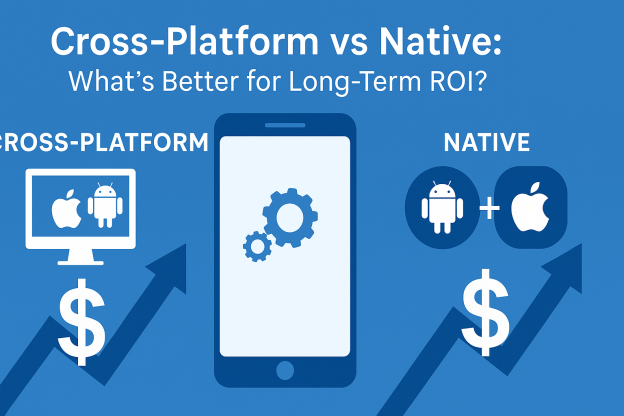Cross-Platform vs Native: What’s Better for Long-Term ROI?

Your manager comes to you with an app idea – which platform should you opt for? The debate centres on whether to select Native or Cross-platform app development for long-term ROI. Choosing between the two is a tough decision, especially when it impacts development time, development cost, time to market, UI, scalability, and long-term ROI.
In this article, we will focus on understanding why the debate centring on ‘cross-platform vs native’ is making waves among developers. Additionally, we will examine the factors associated with both approaches to determine which one offers long-term success.
Native App Development
Suppose your manager needs an app for Android devices. Being a developer, you know the languages for Android app development. You can write code in Kotlin/Java for Android. Now, your manager asks you to create an app for iOS devices as well. You can write code separately for iOS devices using Swift or Objective-C. Now you have two separate codebases for the same app that runs on Android and iOS. This is called native app development.
When you use platform-specific languages and tools to create apps from scratch, it’s native app development. Such apps can benefit from the platform’s capabilities. Extending native apps and scaling them as per user needs is easy and efficient. Native apps provide high performance and allow the use of complex functions. Some popular examples of native applications include X (formerly Twitter), Spotify app, WhatsApp, etc.
Cross-Platform App Development
Imagine writing code for an app just once, and it runs on various operating systems. This is what cross-app development is. Developers can use powerful technologies like Flutter and React Native to deploy apps using a single codebase. Cross-platform development is an efficient approach to app development due to a number of reasons. This saves a lot of development time, along with which it provides cost-effective development.
Businesses can leverage cross-platform tools like React Native and Flutter for seamless app development. They do not need a different team of developers to write the code separately for iOS and Android. With a single codebase, the app will be easier to manage and maintain throughout the development lifecycle. Many popular apps, such as Instagram, Google Pay, and Skype, utilise a cross-platform development approach.
Comparing Limitations of Native vs Cross-Platform App Development
Performance
Compared to cross-platform apps, native apps are better in performance. Cross-platform apps have an additional layer of abstraction and a need for rendering, which leads to slower performance. Users can download native apps directly to their mobile devices. Their optimisation is effective for specific platforms. As opposed to that, cross-platform apps do not match the performance of a native app, even though they provide solid functionality.
To put it more simply, in native app development, the codebase for Android and iOS is different. The developers create native apps for specific operating systems, which allows quick rendering and gives optimum performance. They have platform-specific APIs through which they can access the system’s hardware more efficiently, such as the camera, GPS, etc. However, the comparison in performance is noticeable with complex applications. Since there is a layer of abstraction between the code and the device, cross-platform app performance is slower in comparison.
Adding New Features and Overall Maintenance
Maintaining native apps is an effort and a time-consuming process. Cross-platform apps are easier to maintain as they have a single codebase. For native apps, adding new updates, features, and functionalities to both codebases is challenging for developers. As opposed to this, adding new features and enabling overall maintenance is easier in cross-platform apps.
Development Cost
The development cost of native applications is higher in comparison. The need for resources increases since there is a need for two separate codebases, i.e., for Android and iOS. This gives increased budget requirements, which is not the case with cross-platform app development. Businesses developing native apps feel like they are building two different projects. They will need platform-specific developers to build native apps.
As opposed to native apps, cross-platform apps have a lower development cost. There is no need for platform-specific developers, which eliminates the demand for additional resources for app development.
Development Time
Native apps require more development time as developers have to make separate codebases for iOS and Android. Businesses wanting to act quickly will not find native app development suitable for their budget and timeline. Developers must ensure that the app developed for iOS has a similar UI to the app developed for Android. There are many intricacies with the UI/UX that developers need to ensure while working on native apps. On the other hand, cross-platform apps take less time in development. Cross-platform apps have a shorter development cycle, which gives them more time to market the product.
Why ROI Matters?
To calculate the ROI of your mobile app, first, you will need to determine the initial development costs, marketing costs or any other associated costs. ROI measures the app’s profitability by comparing the invested amount with the generated revenue. A positive ROI will indicate that your app is profitable, while a negative ROI will indicate otherwise. But why is calculating ROI important?
Suppose you have a new business and you need an app which supports various OS. In this case, you might look for an approach that meets your platform-specific requirements to create an app. Now, depending on various factors, you will choose between a native app and a cross-platform app. These factors include the time it takes to develop the app, the cost of development, the maintenance cost and the time needed to market the app.
A positive ROI will depend primarily on the aforementioned factors. Investing less in applications does not mean compromising with user requirements. The cross-platform apps have all the essential features and functionalities. They are highly scalable and easy to maintain effectively as they use only a single codebase. A positive ROI will ensure success for your business. Hence, choosing which approach to app development is effective will depend on your business and app requirements.
What should you do?
Considering the factors related to development time, budget, time needed to market the app and its scalability, you can decide between native vs cross-platform development. Both approaches are grounded in their features and capabilities. Both approaches have their benefits and drawbacks. It’s important to ensure that your chosen approach aligns with the overall project goals.
However, when it comes to ROI, cross-platform apps offer a better return on investment. This is due to having lower development and maintenance costs. Cross-platform app development offers less development time as compared to native app development. Hence, the development cycle of cross-platform apps is faster in comparison. In terms of performance, native apps are better than cross-platform apps. For certain high-performing apps, you can opt for a native development approach. Some popular platforms for developing cross-platform apps include Flutter, React Native and Ionic.
To Sum Up
Cross-platform app development provides scalable and easily maintainable applications. As opposed to this, native apps are widely known for their performance, which is still a shortcoming in cross-platform apps. However, to ensure long-term ROI for your business, you can choose a cross-platform development approach. In this approach, developers maintain a single codebase for different operating systems. Your project requirements may change over time, but cross-platform development ensures that adding new features and functionalities is feasible.
If you have app development needs for your business, reach out to our developers to discuss its scope and budget requirements. We at VerveLogic will be thrilled to help you with your project needs.




